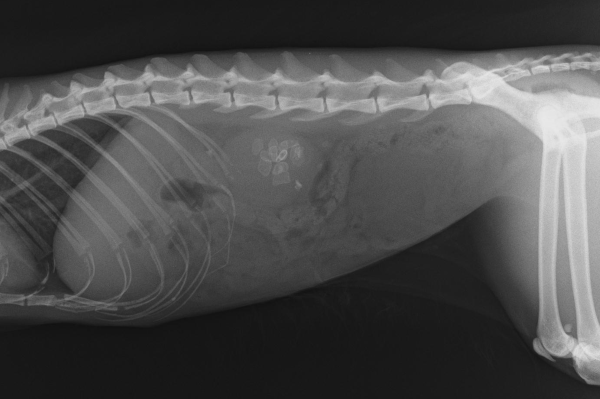RVC research finds cat breeds at highest risk of kidney stones
Researchers from the Royal Veterinary College (RVC) have found the breeds that place cats at a higher risk of developing kidney and ureter stones, namely Burmese, Persian, Ragdoll and Tonkinese breeds. The research is the first of its kind to examine all cats with upper urinary tract uroliths (stones) as one group and hopes to support vets with diagnostic and treatment plans.

The frequency of diagnosis of upper urinary tract uroliths in cats, known as stones in the kidney or ureter, has been increasing in the last two decades, with 4.6% of the cats referred to the RVC’s Queen Mother Hospital for Animals over a 10-year period having upper urinary tract uroliths. The last similar estimate in the USA was in 1999, when just 0.68% in cats seen at veterinary teaching hospitals were diagnosed with upper urinary tract uroliths.
Similar to humans, feline uroliths are usually composed of calcium oxalate. This cannot be dissolved naturally via diet or medication, and there are currently no effective methods for preventing these stones from forming in cats. If these stones move into the ureter, they can cause an obstruction (blockage) which can be life-threatening and often requires surgical intervention. However, there is a lack of studies examining the frequency of upper urinary tract uroliths in cats in the UK.
The RVC’s VetCompass™ Programme set out to conduct the first study examining all cats with upper urinary tract uroliths. The research team performed an observational cross-sectional cohort study of all the cats seen as referral patients at the Queen Mother Hospital for Animals over a 10 year period. The team examined 11,431 cats that had been assessed using abdominal imaging such as ultrasound, x-ray and CT scans and identified 521 cats with evidence of upper urinary tract uroliths.
The study found five cat breeds that were at increased risk of a diagnosis of upper urinary tract stones compared to non-purebred cats. These were British shorthair, Burmese, Persian, Ragdoll and Tonkinese. However, non-purebred cats (most frequently Domestic Shorthair) still numerically make up the majority of the felines seen with this condition. This is also the first study to show that the younger a cat is when diagnosed with kidney stones, the higher the risk of it developing a ureteral obstruction.
The other key outcomes were:
- Risk factors for a diagnosis of upper urinary tract uroliths are being female (versus male), being British shorthair, Burmese, Persian, Ragdoll or Tonkinese (versus non-purebred cats) and being ≥ 4 years of age.
- Cats aged 4-8 years of age have the highest risk of being diagnosed with upper urinary tract uroliths.
- Risk factors for cats with these uroliths developing ureteral obstruction (potentially life-threatening) are being female, having uroliths in both kidneys and being a younger age.
The findings of the study help to inform the veterinary profession about the increased risk for upper urinary tract stones in younger cats and highlight that patients presenting with azotaemia (increased kidney markers) under 12 years of age should have upper urinary tract uroliths considered as an underlying cause of their condition. The study also shows that the younger a cat is at diagnosis of kidney stones, the more likely it is to develop ureteral obstruction and therefore cats that are presenting as unwell with a known history of this condition should always be checked for the possibility that obstruction has occurred.
_in_cats-thumb.jpg)
Rebecca Geddes, Lecturer in Small Animal Internal Medicine at the RVC, said:
“This study highlights that cats diagnosed with kidney stones at a young age are at higher risk for ureteral obstruction than older cats. Vets should be aware that cats presenting with azotaemia (particularly if under 12 years of age) could have a ureteral obstruction and require abdominal imaging to rule this out. “
Dan O’Neill, Associate Professor in Companion Animal Epidemiology at the RVC, said:
“Individual veterinary professionals work really hard to improve the lives of each cat that they care for but this study shows that now they can also help thousands of other cats by contributing anonymised clinical data to Big Data projects such as VetCompass.”
Notes to Editors
Reference
Geddes RF, Davison LJ, Elliott J, Syme HM, O'Neill DG. Risk factors for upper urinary tract uroliths and ureteral obstruction in cats under referral veterinary care in the United Kingdom. J Vet Intern Med. 2023; 1‐11. doi:10.1111/jvim.16659
The full URL for the article is: i: http://doi.org/10.1111/jvim.16659
For media enquiries, please contact:
- jasmin.devivo@plmr.co.uk or rvc@plmr.co.uk
- Press Line: 0800 368 9520
About the RVC
- The Royal Veterinary College (RVC) is the UK's largest and longest established independent veterinary school and is a Member Institution of the University of London.
- It is one of the few veterinary schools in the world that hold accreditations from the RCVS in the UK (with reciprocal recognition from the AVBC for Australasia, the VCI for Ireland and the SAVC for South Africa), the EAEVE in the EU, and the AVMA in the USA and Canada.
- The RVC is ranked as the top veterinary school in the world in the QS World University Rankings by subject, 2022.
- The RVC offers undergraduate and postgraduate programmes in veterinary medicine, veterinary nursing and biological sciences.
- The RVC is a research led institution with 88% of its research rated as internationally excellent or world class in the Research Excellence Framework 2021.
- The RVC provides animal owners and the veterinary profession with access to expert veterinary care and advice through its teaching hospitals and first opinion practices in London and Hertfordshire.


